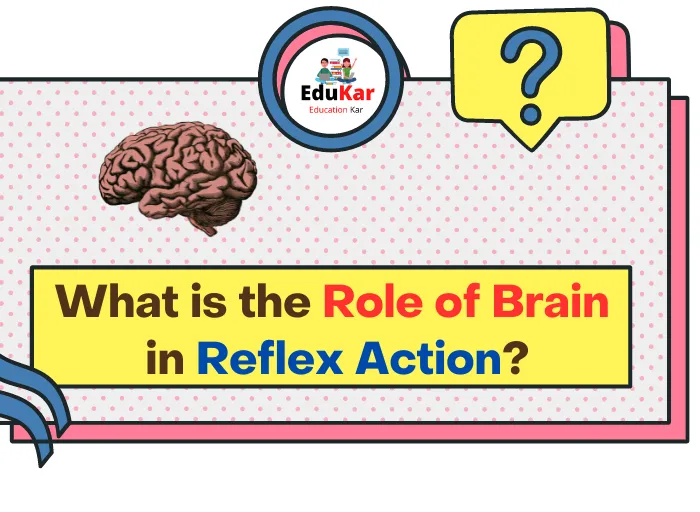Contents
- 1 What is Reflex Action?
- 2 What is the Role of Brain in Reflex Action?
- 3 Question’s related to the Role of Brain in Reflex Action.
- 3.1 1. What is the definition of a reflex action, and how is it different from a voluntary action?
- 3.2 2. What are the main components of a reflex arc, and how do they work together?
- 3.3 3. How does the brain process and interpret sensory information received from the body during a reflex action?
- 3.4 4. How does the brain initiate and control the motor response during a reflex action?
- 3.5 5. How does the speed of a reflex action differ from that of a voluntary action, and why?
- 3.6 6. What are some examples of reflex actions that are controlled by the brain?
- 3.7 7. How can reflex actions be used to diagnose neurological disorders or injuries?
- 3.8 8. How do drugs or other substances affect reflex actions, and what are the potential consequences?
- 3.9 9. What are some of the evolutionary advantages of having reflex actions controlled by the brain?
- 3.10 10. How can knowledge of the brain’s role in reflex actions be used to develop new treatments for neurological disorders or injuries?

What is Reflex Action?
Reflex action, also known as a reflex, is an automatic and rapid response of the body to a particular stimulus without the involvement of conscious thought or decision-making processes. It is an involuntary action that occurs in response to an external or internal stimulus, such as a touch, pain, or sudden movement.
The reflex action involves a specific pathway in the nervous system called the reflex arc, which includes a sensory receptor, a sensory neuron, an interneuron, a motor neuron, and an effector (such as a muscle or gland). When the sensory receptor is stimulated, it sends a signal through the sensory neuron to the spinal cord, where the interneuron relays the signal to the motor neuron. The motor neuron then sends a signal to the effector, causing it to respond with a reflex action.
Reflex actions are important for survival, as they allow the body to quickly respond to potential danger or other stimuli without the need for conscious processing. Examples of reflex actions include pulling your hand away from a hot stove, blinking in response to a sudden bright light, or jerking your leg in response to a tap on the knee.
What is the Role of Brain in Reflex Action?
Although reflex actions are often thought of as purely automatic responses, the brain plays a crucial role in coordinating and modulating these actions.
When a stimulus triggers a reflex action, sensory information is transmitted to the spinal cord, which then sends a signal to the brain. The brain receives and processes this information, and may modify the reflex response based on the context and other factors. For example, if you accidentally touch a hot stove, your reflex action may be to pull your hand away immediately, but the brain may also override this response if it determines that the situation warrants a different action, such as grabbing a nearby pot holder instead.
Furthermore, certain reflexes are actually controlled by the brainstem or other higher brain regions, rather than just the spinal cord. These reflexes, such as the gag reflex or the pupillary light reflex, involve more complex neural pathways that involve both sensory and motor areas of the brain.
Also Read: Difference Between Reflex Action and Walking
1. What is the definition of a reflex action, and how is it different from a voluntary action?
Ans. A reflex action is an involuntary and automatic response of the body to a particular stimulus. It is a rapid and pre-programmed response that does not involve conscious thought or decision-making processes. Reflex actions are controlled by specific neural pathways called reflex arcs, which include a sensory receptor, a sensory neuron, an interneuron, a motor neuron, and an effector.
Voluntary actions are conscious actions that are initiated and controlled by the brain. They require conscious thought and decision-making processes, and involve complex neural circuits that coordinate sensory information, motor planning, and execution.
The main difference between reflex actions and voluntary actions is that reflex actions occur automatically and do not involve conscious thought or decision-making, while voluntary actions are conscious and require a conscious decision to initiate and control the action. Reflex actions are also typically faster and more stereotyped than voluntary actions, since they do not require the same level of processing and planning.
2. What are the main components of a reflex arc, and how do they work together?
Ans. The main components of a reflex arc are:
- Sensory receptor: A specialized cell or structure that detects a specific stimulus, such as pressure, temperature, or pain.
- Sensory neuron: A nerve cell that carries the sensory information from the receptor to the spinal cord or brainstem.
- Interneuron: A nerve cell that acts as a mediator between the sensory neuron and the motor neuron in the spinal cord or brainstem.
- Motor neuron: A nerve cell that carries the signal from the spinal cord or brainstem to the effector, such as a muscle or gland.
- Effector: A muscle or gland that responds to the motor neuron signal by contracting or secreting a substance.
When a sensory receptor is stimulated, it sends a signal through the sensory neuron to the spinal cord or brainstem. The interneuron in the spinal cord or brainstem then relays the signal to the motor neuron, which sends a signal to the effector. The effector then responds by contracting or secreting a substance, which produces the reflex action.
The reflex arc is a rapid and pre-programmed pathway that allows for quick and automatic responses to potential danger or other stimuli without the need for conscious processing. The components of the reflex arc work together to detect the stimulus, process the sensory information, and produce an appropriate motor response, all within a fraction of a second.
3. How does the brain process and interpret sensory information received from the body during a reflex action?
Ans. When a sensory receptor is stimulated during a reflex action, it sends a signal through the sensory neuron to the spinal cord. In the spinal cord, the sensory neuron synapses with an interneuron, which in turn synapses with a motor neuron that sends a signal to the effector (such as a muscle).
At the same time, the sensory information is also transmitted to the brain via ascending sensory pathways. The brain receives and processes this information to interpret the nature and intensity of the stimulus, and to coordinate the reflex response with other cognitive processes and environmental factors.
The sensory information is first transmitted to the primary sensory cortex, which is responsible for processing basic sensory information such as touch, pain, and temperature. The sensory cortex then sends this information to other higher-level areas of the brain, such as the somatosensory association cortex, which integrates sensory information with other cognitive processes such as memory and attention.
The brain also plays a role in modulating reflex actions by sending descending motor signals to the spinal cord. These signals can either enhance or inhibit the reflex response, depending on the context and other factors.
4. How does the brain initiate and control the motor response during a reflex action?
Ans. During a reflex action, the brain does not directly initiate or control the motor response, as the reflex response is automatic and pre-programmed. Instead, the reflex response is initiated and controlled by the reflex arc, which includes the sensory receptor, sensory neuron, interneuron, motor neuron, and effector.
However, the brain can modulate and coordinate the reflex response through descending motor signals that are sent from the brain to the spinal cord. These signals can either enhance or inhibit the reflex response, depending on the context and other factors.
For example, if a person accidentally touches a hot stove, the reflex response may be to immediately pull their hand away. However, if the situation warrants a different response (such as grabbing a nearby pot holder instead), the brain may send a descending motor signal to inhibit the reflex response and initiate a different motor response.
In some cases, reflex responses may also be influenced by higher-level cognitive processes, such as attention and expectation. For example, if a person is expecting a certain stimulus, their reflex response may be enhanced or inhibited depending on their expectations.
5. How does the speed of a reflex action differ from that of a voluntary action, and why?
Ans. The speed of a reflex action is generally faster than that of a voluntary action. This is because reflex actions are pre-programmed and do not involve conscious thought or decision-making processes, which allows them to be initiated and executed rapidly.
In a reflex action, the sensory receptor detects a stimulus and sends a signal through the sensory neuron to the spinal cord, where it is relayed to the motor neuron and then to the effector. This process occurs within a fraction of a second and results in a rapid and automatic response to the stimulus.
Voluntary actions involve conscious thought and decision-making processes, which require more time to process and execute. During a voluntary action, the brain must first receive and interpret sensory information, then plan and initiate the motor response, and finally execute the response. This process can take several hundred milliseconds or even seconds, depending on the complexity of the action.
6. What are some examples of reflex actions that are controlled by the brain?
Ans. There are many examples of reflex actions that are controlled by the brain. Here are some common examples:
- Blinking reflex: When an object suddenly approaches the eye or when the eye is exposed to a bright light, the brain sends a signal to the muscles around the eye, causing it to blink reflexively to protect the eye.
- Gag reflex: When the back of the throat is stimulated, such as by an object touching the uvula or by a strong taste or odor, the brain sends a signal to the muscles of the throat, causing them to contract reflexively and expel the stimulus.
- Knee-jerk reflex: When the patellar tendon (located just below the kneecap) is tapped, the brain sends a signal to the quadriceps muscle in the thigh, causing it to contract reflexively and extend the leg.
- Withdrawal reflex: When the skin is exposed to a painful or noxious stimulus, such as touching a hot object or stepping on a sharp object, the brain sends a signal to the muscles of the affected body part, causing it to contract reflexively and withdraw from the stimulus.
- Pupillary reflex: When the amount of light entering the eye changes, the brain sends a signal to the muscles of the iris, causing it to contract or relax reflexively to adjust the size of the pupil.
These reflex actions are important for protecting the body from potential harm and maintaining homeostasis, and they are controlled by the brain through the reflex arc.
7. How can reflex actions be used to diagnose neurological disorders or injuries?
Ans. Reflex actions can be used to diagnose neurological disorders or injuries through a series of tests that assess the function of the nervous system. Reflexes are involuntary responses to stimuli, and changes in reflexes can indicate damage or dysfunction of the nervous system.
There are several types of reflex tests that can be used to diagnose neurological disorders or injuries, including:
- Deep tendon reflex test: This test involves tapping the tendon with a reflex hammer, which causes a muscle contraction. The strength and speed of the reflex can indicate damage to the nerves or spinal cord.
- Babinski reflex test: This test involves stroking the sole of the foot, which should cause the toes to curl downwards. In individuals with neurological damage or disorders, the big toe may instead move upwards or the toes may spread out.
- Hoffman’s reflex test: This test involves flicking the fingernail or thumbnail, which should cause a quick finger flexion. In individuals with neurological damage or disorders, the reflex may be exaggerated.
- Clonus test: This test involves forcefully extending and holding the foot, which should cause a few quick contractions of the calf muscles. In individuals with neurological damage or disorders, the contractions may continue for an extended period of time.
By performing these tests and analyzing the results, healthcare professionals can gain insight into the functioning of the nervous system and identify potential neurological disorders or injuries. However, it is important to note that these tests are not definitive and should be used in conjunction with other diagnostic tools to accurately diagnose neurological conditions.
8. How do drugs or other substances affect reflex actions, and what are the potential consequences?
Ans. Drugs and other substances can affect reflex actions in various ways, depending on the substance and the individual. Some drugs may enhance reflexes, while others may suppress them or cause abnormal reflex responses. Here are a few examples of how different substances can affect reflex actions:
- Alcohol: Alcohol is a depressant that can slow down reflex actions, making them slower and weaker. This can lead to impaired coordination, balance, and reaction time, increasing the risk of accidents and injuries.
- Stimulants: Stimulants such as cocaine and amphetamines can enhance reflexes, making them faster and more pronounced. However, this can also lead to overstimulation, hyperactivity, and erratic behavior.
- Opioids: Opioids such as heroin and prescription painkillers can depress reflexes, making them weaker and slower. This can cause drowsiness, confusion, and impaired coordination.
- Anesthetics: Anesthetics such as lidocaine and propofol can suppress reflexes, making them non-responsive or absent. This is necessary during medical procedures to prevent involuntary movements that could interfere with the surgery or cause harm to the patient.
The potential consequences of substance-induced changes in reflex actions depend on the individual, the dose, and the circumstances. In some cases, altered reflex responses can impair daily activities such as driving, walking, or using machinery, increasing the risk of accidents and injuries. In other cases, abnormal reflexes may be a sign of drug toxicity or overdose, requiring immediate medical attention. It is important to follow medication instructions carefully and avoid combining different substances without medical supervision to minimize the risk of adverse effects on reflex actions and overall health.
9. What are some of the evolutionary advantages of having reflex actions controlled by the brain?
Ans. Reflex actions are involuntary, rapid responses to external stimuli that do not require conscious thought or decision-making. These reflexes are controlled by the brainstem and spinal cord, which allow for fast and automatic reactions to potentially dangerous or beneficial stimuli. Here are some of the evolutionary advantages of having reflex actions controlled by the brain:
- Protection from harm: Reflex actions are essential for protecting the body from harm by allowing for rapid responses to potentially dangerous stimuli, such as withdrawing a hand from a hot stove or blinking to protect the eyes from debris.
- Quick and efficient response: Reflex actions are faster than conscious movements, allowing for quick and efficient responses that can increase survival rates. For example, the blink reflex can occur in as little as 100 milliseconds, which can protect the eyes from damage faster than a conscious decision to blink.
- Energy conservation: Reflex actions are energy-efficient because they do not require conscious thought or decision-making, which can be taxing on the brain and body. This allows the body to conserve energy for other vital functions.
- Adaptability: Reflex actions can be modified through training and conditioning, allowing individuals to adapt to new environments and situations. For example, athletes can train their reflexes to react faster and more accurately to specific stimuli, such as a tennis player returning a fast serve.
10. How can knowledge of the brain’s role in reflex actions be used to develop new treatments for neurological disorders or injuries?
Ans. Knowledge of the brain’s role in reflex actions can be used to develop new treatments for neurological disorders or injuries in several ways. Here are a few examples:
- Understanding the neural pathways involved in reflex actions can help identify the areas of the brain that are affected by neurological disorders or injuries. This can help guide treatment options and improve outcomes for patients.
- Developing therapies that target the neural circuits involved in reflex actions can help restore lost function or improve motor control. For example, electrical stimulation of the spinal cord or brainstem can activate reflex pathways and enhance motor function in individuals with spinal cord injuries or other neurological disorders.
- Studying the changes in reflex responses over time can help track the progression of neurological disorders or injuries and evaluate the effectiveness of treatments. This can inform the development of new therapies and improve the overall management of these conditions.
- Developing diagnostic tools that assess reflex actions can aid in the early detection and diagnosis of neurological disorders or injuries. This can help guide treatment options and improve outcomes for patients.



![Zoology Important Questions [Class 11th-English medium] Zoology Important Questions class 10 english medium](https://edukar.in/wp-content/uploads/2022/09/Zoology-Important-Questions-class-10-english-medium-1024x597.webp)

![Biology Class 10 Very important [Questions &Answers] Biology Important Questions with Answers class 10](https://edukar.in/wp-content/uploads/2022/09/Biology-Important-Questions-with-Answers-class-10-1024x597.webp)
![Corporate Accounting [Important Questions & Answers with MCQ] Corporate Accounting Important Questions & Answers](https://edukar.in/wp-content/uploads/2022/09/Corporate-Accounting-Important-Questions-Answers-1024x597.webp)




![What is Sublimation with Examples? [Class 9,10th,11th] What is Sublimation with Examples](https://edukar.in/wp-content/uploads/2023/03/What-is-Sublimation-with-Examples.webp)
![Digital Documentation Class 9 [Questions Answers & MCQ] Digital Documentation Class 9](https://edukar.in/wp-content/uploads/2022/08/Digital-Documentation-Class-9-1024x597.webp)

![Web application and Security Class 10 [Questions Answers & MCQs] Web application Class 10 Questions & Answers](https://edukar.in/wp-content/uploads/2022/09/Web-application-Class-10-Questions-Answers-1024x597.webp)
![What Is Colloidal Solution? [Class 9,10,11&12] What Is Colloidal Solution](https://edukar.in/wp-content/uploads/2022/08/What-Is-Colloidal-Solution-1024x597.webp)
